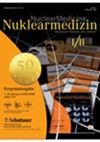Radiation doses from low-dose CT scans in SPECT/CT and PET/CT examinations: A survey in Germany.
IF 1.2
4区 医学
Q4 RADIOLOGY, NUCLEAR MEDICINE & MEDICAL IMAGING
引用次数: 2
Abstract
AIM Recently, dose reference levels (DRLs) have been defined in Germany for auxiliary low-dose CT scans in hybrid SPECT/CT and PET/CT examinations, based on data from 2016/17. Here, another survey from 2020 was evaluated and compared with the new DRLs as well as with similar surveys from foreign countries. METHODS The survey, which had already been conducted in the Nordic countries, queried for various examinations including the following values: patient weight and height, volume CT dose index (CTDIvol), dose length product (DLP). For each examination, statistical parameters such as the third quartile (Q3) were determined from all submitted CTDIvol and DLP values. Additionally, for examinations comprising datasets from at least 10 systems, the third quartile (Q3-Med) of the respective median values of each system was calculated. Q3 and Q3-Med were compared with the newly published DRLs from Germany and values from similar studies from other countries. RESULTS Data from 15 SPECT/CT and 13 PET/CT systems from 15 nuclear medicine departments were collected. For the following examinations datasets from more than 10 systems were submitted: SPECT lung VQ, SPECT bone, SPECT&PET cardiac, PET brain, PET oncology. Especially for examinations of the thorax and heart, the new DRLs are very strict compared to this study. The CTDIvol values for examinations of the head were lower in this study than the DRLs prescribe now. CONCLUSIONS For certain examination types, there is a need for dose optimization at some clinics and devices in order to take into account the new DRLs in Germany in the future.SPECT/CT和PET/CT低剂量CT扫描的辐射剂量:德国的一项调查。
最近,根据2016/17年的数据,德国已经为混合SPECT/CT和PET/CT检查中的辅助低剂量CT扫描定义了剂量参考水平(drl)。在这里,对2020年的另一项调查进行了评估,并与新的drl以及国外的类似调查进行了比较。方法该调查已在北欧国家开展,调查内容包括患者体重和身高、体积CT剂量指数(CTDIvol)、剂量长度积(DLP)等。对于每次检查,从所有提交的CTDIvol和DLP值中确定统计参数,如第三四分位数(Q3)。此外,对于包含来自至少10个系统的数据集的检查,计算每个系统各自中位数的第三四分位数(Q3-Med)。将Q3和Q3- med与德国新发表的drl和其他国家类似研究的值进行比较。结果收集了15个核医学科室的15台SPECT/CT和13台PET/CT系统的数据。提交了来自10多个系统的以下检查数据集:SPECT肺VQ, SPECT骨,SPECT&PET心脏,PET脑,PET肿瘤。特别是对于胸部和心脏的检查,新的drl与本研究相比非常严格。在本研究中,头部检查的CTDIvol值低于目前规定的drl。结论对于某些检查类型,一些诊所和设备需要优化剂量,以适应未来德国新的drl。
本文章由计算机程序翻译,如有差异,请以英文原文为准。
求助全文
约1分钟内获得全文
求助全文
来源期刊
CiteScore
1.70
自引率
13.30%
发文量
267
审稿时长
>12 weeks
期刊介绍:
Als Standes- und Fachorgan (Organ von Deutscher Gesellschaft für Nuklearmedizin (DGN), Österreichischer Gesellschaft für Nuklearmedizin und Molekulare Bildgebung (ÖGN), Schweizerischer Gesellschaft für Nuklearmedizin (SGNM, SSNM)) von hohem wissenschaftlichen Anspruch befasst sich die CME-zertifizierte Nuklearmedizin/ NuclearMedicine mit Diagnostik und Therapie in der Nuklearmedizin und dem Strahlenschutz: Originalien, Übersichtsarbeiten, Referate und Kongressberichte stellen aktuelle Themen der Diagnose und Therapie dar.
Ausführliche Berichte aus den DGN-Arbeitskreisen, Nachrichten aus Forschung und Industrie sowie Beschreibungen innovativer technischer Geräte, Einrichtungen und Systeme runden das Konzept ab.
Die Abstracts der Jahrestagungen dreier europäischer Fachgesellschaften sind Bestandteil der Kongressausgaben.
Nuklearmedizin erscheint regelmäßig mit sechs Ausgaben pro Jahr und richtet sich vor allem an Nuklearmediziner, Radiologen, Strahlentherapeuten, Medizinphysiker und Radiopharmazeuten.

 求助内容:
求助内容: 应助结果提醒方式:
应助结果提醒方式:


